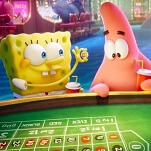As the strange beast known as “cable television” found its footing in the ’80s, burgeoning networks struggled to fill the daylight hours with content. While MTV and Nickelodeon scraped together their shoestring budgets to produce charming, low-rent entertainment, no amount of improvising could possibly fill an entire schedule. So, along with importing content from overseas, many networks looked to the past to pad out their programming—the last half-century of cinema provided countless hours of filler, and for cheap. Many of these films, though, only existed in black and white, and programming executives believed that colorless content was a hard sell for viewers who presumably wanted nothing but Technicolor bliss from their television sets.
The solution was “colorization,” which promised to revitalize decades’ worth of movies seen as too dated to be shown in their extant forms. In practice, this computer magic made actors look pallid and ghoulish, and it rendered scenery in the pastel hues of a PAAS Easter egg kit. But those aesthetic shortcomings didn’t stop cable mogul Ted Turner from aggressively supporting the technology. His repeated attempts to smash commerce into art eventually earned colorization the pejorative “Turnerization,” and Turner’s mania reached a fever pitch in the late ’80s when he announced his intent to transform Citizen Kane into a smear of muted colors. After the appropriate public outcry, colorization couldn’t be seen as anything but gauche, and there was a collapse in the demand to see classic films mutilated—if that demand had ever existed.
In 2014, classic games face nearly the same problem that threatened classic films during cable TV’s rise to power. The proliferation of smartphones means that video games are now available to a previously untapped market, and studios haven’t been shy about drawing upon their archives to make a quick buck on the various app stores. Like a new generation of Ted Turners, publishers like Square-Enix and Sony, among others, have shown little respect for their industry’s past, viewing former technological constraints as fixable problems. Beloved classics are being altered in an attempt to appeal to the modern consumer, and for the sake of competing in a crowded market. But while the world of film has a phalanx of critics, historians, and educators standing watch over the treasures of the past, these same figures in video games don’t have enough clout to stop publishers from their frequent meddling.
Anyone interested in trying out these older games in mobile form won’t be experiencing the works as they were meant to be seen, though. Square Enix’s re-releases of these classics have given them a makeover straight out of the school of Glamour Shots. While the graphics of these games are “technically” better, they possess a tackiness that the meticulously designed 2D graphics of the past did not. The remakes have an amateur, slapdash quality to them, offering an interface with less flair than Microsoft Word 95 and character art that features a hazy filter in lieu of the original game’s meticulous detail. And Square-Enix’s Dragon Quest games—generally treated with more reverence than Final Fantasy—hasn’t fared much better. While the Dragon Quest ports (currently planned only for Japan) retain the general look of the originals, their graphics—intended for older televisions with technologically inferior, narrower screens—have been stretched improperly, as if imprinted on some sort of digital silly putty.
While the growth of digital storefronts on the PlayStation 3, Xbox 360, and Nintendo Wii sparked a renewed interest in classic gaming, the newer consoles aren’t as retro-friendly. Sony eliminated any trace of their bare-bones PlayStation emulation with the PS4, giving players no way to check out any of the numerous PS1 titles that are available on the PlayStation 3’s PSN Store. Sony’s planned PlayStation Now service, which will stream PlayStation 1, 2, and 3 games, could bring a healthy selection of classic games to PS4 owners, but Sony’s current lack of interest could very well be a sign that they’re not willing to commit the resources to that kind of revival, at least outside of a handful of expected mega-hits like Final Fantasy VII and Metal Gear Solid. Nintendo is the only console manufacturer that has made a concerted effort to preserve and profit from its past—the Wii’s “Virtual Console” built up an impressive library of classics and relative obscurities presented with their original visuals—but that’s most likely because Nintendo’s past is especially profitable. Even so, the Wii U’s Virtual Console has mainly limited itself to redistributing selections from the last seven years of the Wii’s Virtual Console.
The 3DS offers a healthy share of games that haven’t previously seen a re-release, like the brilliant Wario Land series, Donkey Kong ’94, and the Legend Of Zelda games released for the Game Boy Color, but the presentation is utilitarian at best and sloppy at worst. Unless you know the secret to viewing these games in their original resolution (holding in “Start” as they load), you’re treated to a blurry image stretched inappropriately across the 3DS’ top screen. Nintendo should at least be given credit for keeping these games at their original aspect ratios; some past re-releases—like the PSP port of Final Fantasy Tactics—have simply smashed a 4:3 image into a wider screen, with no concern about how hideous it looks.
This would be a hopeless situation if not for a few companies devoted to preserving classic games. Steam and GOG, two prominent digital stores focused on PC games, have had success making older titles available that are compatible with newer machines—GOG even gave away Fallout, Fallout 2, and Fallout Tactics for free as part of a recent promotion. And on the 3DS, the M2 studio—whose work rarely strays far from Japan—recently released slavish recreations of Genesis greats like Ecco The Dolphin and Streets Of Rage. These careful remakes include just about every option a retro gaming obsessive could desire: You can even choose which model of the Genesis you want to emulate. You have to wonder why M2’s talents are being put to use on Altered Beast instead of, say, Yoshi’s Island—the original version of which has never seen a release on any Virtual Console—but it’s at least refreshing to see a developer handling these old games with the care they deserve.
Game preservation’s worst-kept secret is that piracy has done the best job of keeping classic games available and relevant. Since the mid-’90s, the Internet’s vast and varied emulation scene has made the history of video games available to anyone willing to skirt the law. And unfortunately, playing some of the best games ever made requires a disregard for copyright. Take Maniac Mansion. An icon of the LucasArts studio’s golden age, it’s one of the most important adventure games ever made, and it’s still entertaining today. If you want to play in 2014, though, you’ll need to download it illegally and run it through an emulator, since it hasn’t been in print for close to 20 years.
Disney, which now owns the rights to the LucasArts library, may never acknowledge the studio’s legacy, but that would just maintain the status quo. Most of the developer’s best titles have never been made available to any digital marketplace. If you’re just learning about LucasArts and want to play games like Sam & Max Hit The Road, Day Of The Tentacle, Full Throttle, and Grim Fandango, you’re on your own. Disney would rather hot-glue lightsabers to the hands of Mickey and Donald dolls than offer players the chance to buy games that Disney executives might not even realize they own.
The games industry has a nasty habit of always looking forward with little regard for the past, and classic games have suffered due to this skewed perspective. At best, retro games make for cheap filler in publishers’ libraries, and the worst-case scenarios have seen formerly amazing classics perverted into shoddy, disposable cash grabs. Since game preservation generally requires more time and money than film preservation, game publishers are less likely to take a vested interest in their history than movie studios. Compared to movies, video games might still be in their infancy, but this medium is certainly experiencing the same growing pains and search for artistic relevance that cinema did so long ago. Recently, an interview with the director of a Kingdom Hearts remake revealed that the source data for Kingdom Hearts—a phenomenally successful game barely more than a decade old—had to be recreated from scratch for the HD re-release thanks to Square-Enix’s haphazard source control.
And that isn’t unusual for the industry. The source code for Sega’s beloved Panzer Dragoon Saga and Vanillaware’s Princess Crown no longer exists, for instance, and Jordan Mechner only recently found the code for his original Prince Of Persia after it had gone missing for 22 years. Consider the film precedent: Only 14 percent of movies from the silent era still exist in their original form. That’s a huge chunk of our recent culture gone. Video game enthusiasts might have picked up the slack with their indomitable efforts to preserve their past, but without the intervention of publishers, they can only do so much. It took massive companies like Nintendo and Sony a good 10 years to capitalize on the retro gaming love fostered by tech-savvy fans who secretly kept this history alive on the Internet through emulation. And today, pirates remain the most trusted shepherds of the art form. It’s a black eye to the industry as a whole when preservation has been devalued to the point where the most comprehensive efforts come about illegally and with no assistance from publishers. But when given the choice between a mangled mobile port and the original, Googling “Final Fantasy VI ROM” may be the best way for players to honor the art they love.







































